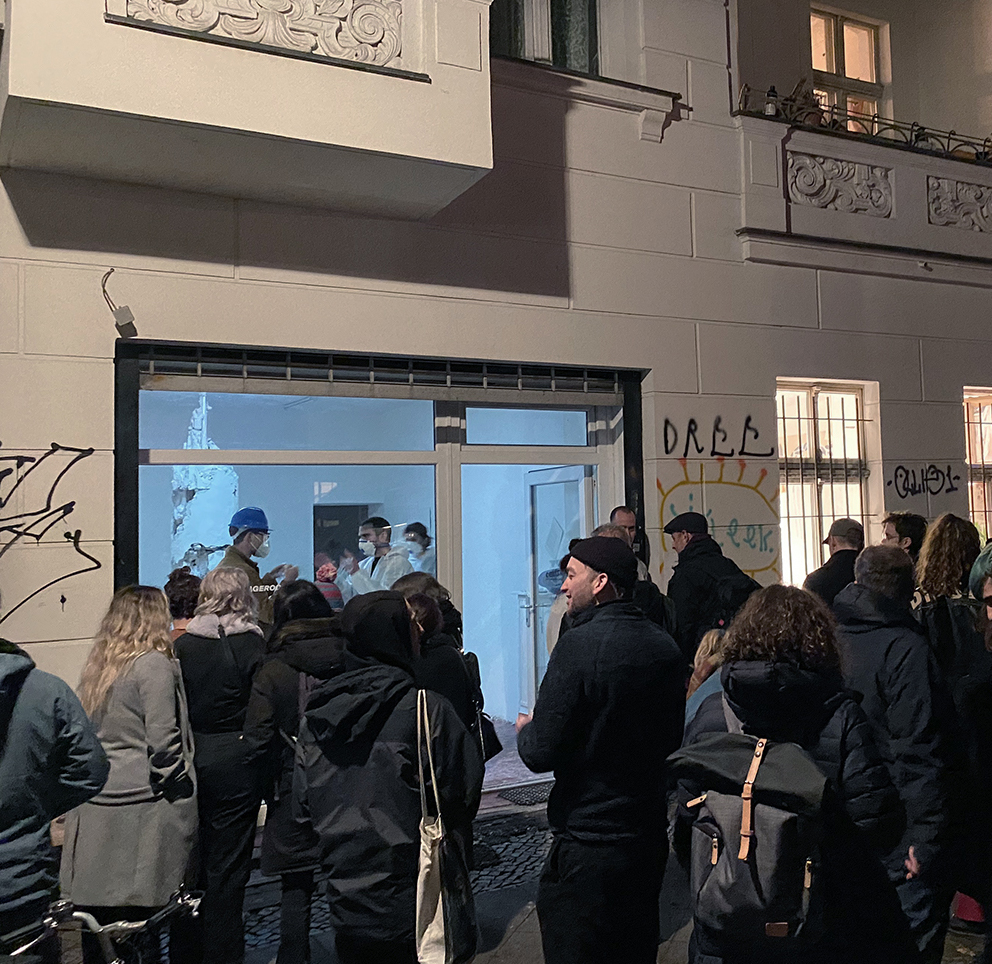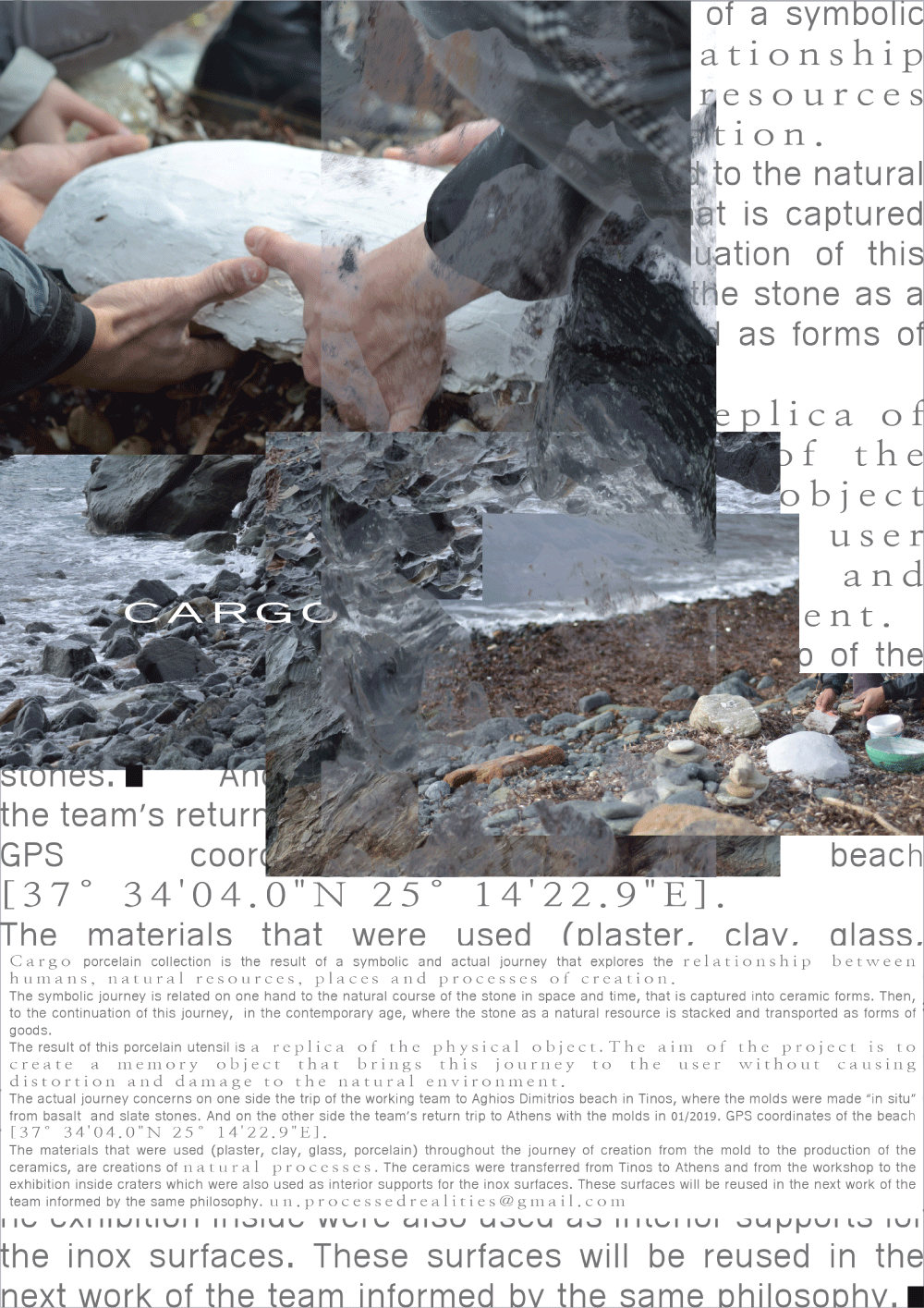UN P R 18T (Un.Processed Realities) were founded in Tinos during the summer of 2018. Their motivation derives from common questions about the operation of the established system of production and exploitation of matter, around the culture of design, the consumer habits, the perception of reality, creation and destruction.
collaboration of Niki Danai Xania | Dimitris Tampakis | Giannis Delatolas
Entropic Garden’ was a temporary installation, part of the Krama Festival 2022. A chaotic garden made of plant waste is assembled around the monolithic steel speakers. This contrast, between organic and metallic, enhances the shift from the topography of these phytomorphic volumes to the constant regularity of the steel rectangle speakers. In this ambiguous staging, fragments of nature appear unexpected and disturbing, disrupting the symbol of itself we have been taught to ‘create’ and appreciate as beautiful and decorative. These fragments suggest an invasive species that is wrapping around the speakers, proposing an alternative vision; an entropic garden where the constituent species will grow and propagate ungovernable and without human intervention.
The moves of the fragments are not randomly created, but they are kinetic translations of the text from chapter XVII – ‘Spring’ – of the philosopher Henry David Thoreau’s book: Walden. The text was translated into numerical values using a software algorithm and then into movement controlled via Arduino. The same chapter can be heard from the speakers among field recordings made by Chris Watson and Francisco Lopez documenting sonically nature from around the world mixed with compositions by Morton Feldman and BJ Nielsen.
Idea, Design, Construction: @un.processedrealities
Music: movement_athens Technical Assistance: @athanasioskatsougiannis Text Editing: @epb.wav Photo: @iro.karavia
UN P R 18T at Centrum Berlin 14 -17 October 2021 Performance & pop-up exhibition
in collaboration with Filippos Raskovic
The various narratives of European philosophy and Reason, as well as, the overwhelming efforts of constructing a geographically based European identity, are crumbling down. Our generation is facing the end of Ratio-Reason and Europe has missed its chance of creating the foundations for a better living. Closed borders, walls, a collapsing European Union, the targeting and marginalisation of states and social groups, with the outbreak of the pandemic as the peak: a rise in the utilisation of science for political reasons, encroachment of human rights, a culture in a coma are some of the examples of the political, economical and humanitarian crisis that Europe is experiencing. Furthermore, a crisis of collective fantasy and of our ability to think of a different future is unfolding. The fossilised classic symbols of Europe remain unchanged, untouchable taboos carrying a stagnant meaning. Their historical legitimisation, resting on a pedestal that rises high above and far away from the present, obstructs any kind of dialogue with the present and the future. Post-European Rage Room is a sculptural and sound installation that will be activated through a performative event on 14 October , and will remain on display until October 17. The installation functions as a representation of a structural element; a pillar with monumental aesthetics, historical references and transmutations. This element will be gradually transformed into archaeological debris, after the destruction of the pillar with the help of the visitors/participants. Music is being placed between two continuous elements. The one is a constant layer of a string quartet. String quartets, ensembles of classical and contemporary western European music and have embodied the principles and the symbolisms of 18th century Enlightenment. The second layer ,on the contrary, consists of continuous, estranged, electronic sounds that are created through a self generative process. This layer tend to destroy the permanence. On top of these two elements one can hear the fragments of a mourning song of Nothern Epirus, a mourning for the lost values. After taking a short quiz, tokens in the shape of EU stars will be given to each visitor, which can be then exchanged for the amount of time and the tool that they want to use in order to destroy the pillar and the symbols which lay hidden inside of it. The design of the objects-symbols that constitute the installation, is the result of an automatic process of production of signified symbols without meaning, thus rendering design into a tool for the reproduction of stereotypical predetermined copies. The destruction of the objects-symbols becomes an organic procedure, as it takes place inside a space that is transformed into a “rage room”.
plaster, guliform, alumium pole and recycled polystyrene
in collaboration with Filippos Raskovic
The various narratives of European philosophy and Reason, as well as, the overwhelming efforts of constructing a geographically based European identity, are crumbling down. Our generation is facing the end of Ratio-Reason and Europe has missed its chance of creating the foundations for a better living. Closed borders, walls, a collapsing European Union, the targeting and marginalisation of states and social groups, with the outbreak of the pandemic as the peak: a rise in the utilisation of science for political reasons, encroachment of human rights, a culture in a coma are some of the examples of the political, economical and humanitarian crisis that Europe is experiencing. Furthermore, a crisis of collective fantasy and of our ability to think of a different future is unfolding. The fossilised classic symbols of Europe remain unchanged, untouchable taboos carrying a stagnant meaning. Their historical legitimisation, resting on a pedestal that rises high above and far away from the present, obstructs any kind of dialogue with the present and the future. Post-European Rage Room is a sculptural and sound installation that will be activated through a performative event on 14 October , and will remain on display until October 17. The installation functions as a representation of a structural element; a pillar with monumental aesthetics, historical references and transmutations. This element will be gradually transformed into archaeological debris, after the destruction of the pillar with the help of the visitors/participants. Music is being placed between two continuous elements. The one is a constant layer of a string quartet. String quartets, ensembles of classical and contemporary western European music and have embodied the principles and the symbolisms of 18th century Enlightenment. The second layer ,on the contrary, consists of continuous, estranged, electronic sounds that are created through a self generative process. This layer tend to destroy the permanence. On top of these two elements one can hear the fragments of a mourning song of Nothern Epirus, a mourning for the lost values. After taking a short quiz, tokens in the shape of EU stars will be given to each visitor, which can be then exchanged for the amount of time and the tool that they want to use in order to destroy the pillar and the symbols which lay hidden inside of it. The design of the objects-symbols that constitute the installation, is the result of an automatic process of production of signified symbols without meaning, thus rendering design into a tool for the reproduction of stereotypical predetermined copies. The destruction of the objects-symbols becomes an organic procedure, as it takes place inside a space that is transformed into a “rage room”.
plaster, guliform, alumium pole and recycled polystyrene


















The ‘Un[processed]’ pieces are conscious reflections around established norms. They mirror the aggressive intervention of man on nature and the general deterioration due to the effect of uncontrollable industrialisation. The maker- designer is a victim of the tragic circumstances that he inevitably is party to, since it is almost impossible to create, without altering or destroying elements of nature.
The solid and realistic assemblages, were born through a dystopian environment forming a spatial relationship, exhibiting a scene of violence. The inox pipe literally rapes the raw and unprocessed marble. This collision highlights the strong antitheses between man and nature, geometrical and organic forms, mass production and naturally occurring configurations.
The inox symbolizes industry, technology and alienation. It is the material used in the production of weaponry and sophisticated, modern machinery. It indicates brute force and strength, immortality and utter perfection, it cannot be destroyed and it never disappoints. These are the ideals of a modern industrialised society. In contrast to this, the unprocessed mass of rock represents nature and eternity. It expresses archetypal emotion and the strength of nature which formed it. The rock is still ‘alive’ as it continues to change, to transform. It has no finalised form, it breaks and crumbles even as it is being handled and transported. Perishability and loss are both in the nature of the rock, as it is enveloped in a poetic weakness.
The origin of the materials is also contradictory. On the one hand the inox and the LED mechanisms are industrialized products, while on the other, remnants of marble masses were selected from the abandoned mines of Tinos.
At the end of the object’s life all its parts are disassembled easily and can then be reused. The rock can be returned to us or its original site following the coordinates etched on the pipe.
The pieces created are not “eco”, they don’t suggest solutions nor do they solve the issues that they wish to raise awareness about. Their aim is to activate the reevaluation of the established methods of production.
First presentation @thessalonikidesignweek
Designed and constructed by #volaxcollective









Cargo porcelain collection is the result of a symbolic and actual journey that explores the relationship between humans, natural resources, places and processes of creation. The symbolic journey is related on one hand to the natural course of the stone in space and time, that is captured into ceramic forms. Then, to the continuation of this journey, in the contemporary age, where the stone as a natural resource is stacked and transported as forms of goods.
The result of this porcelain utensil is a replica of the physical object. The aim of the project is to create a memory object that brings this journey to the user without causing distortion and damage to the natural environment.
The actual journey concerns on one side the trip of the working team to Aghios Dimitrios beach in Tinos, where the molds were made “in situ” from basalt and slate stones. And on the other sid the team’s return trip to Athens with the molds in 01/2019. GPS coordinates of the beach [37°34'04.0"N 25°14'22.9"E].
The materials that were used (plaster, clay, glass, porcelain) throughout the journey of creation from the mold to the production of the ceramics, are creations of natural processes. The ceramics were transferred from Tinos to Athens and from the workshop to the exhibition inside crakters which were also used as interior supports for the inox surfaces. These surfaces will be reused in the next work of the team informed by the same philosophy.
The result of this porcelain utensil is a replica of the physical object. The aim of the project is to create a memory object that brings this journey to the user without causing distortion and damage to the natural environment.
The actual journey concerns on one side the trip of the working team to Aghios Dimitrios beach in Tinos, where the molds were made “in situ” from basalt and slate stones. And on the other sid the team’s return trip to Athens with the molds in 01/2019. GPS coordinates of the beach [37°34'04.0"N 25°14'22.9"E].
The materials that were used (plaster, clay, glass, porcelain) throughout the journey of creation from the mold to the production of the ceramics, are creations of natural processes. The ceramics were transferred from Tinos to Athens and from the workshop to the exhibition inside crakters which were also used as interior supports for the inox surfaces. These surfaces will be reused in the next work of the team informed by the same philosophy.